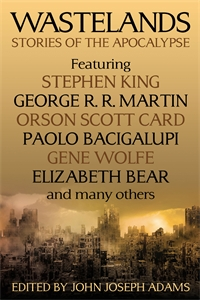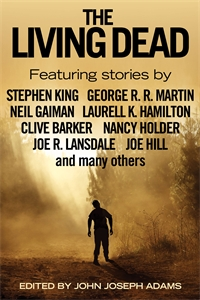THE LIVING DEAD – a zombie anthology featuring Stephen King, George R. R. Martin and Neil Gaiman
We’ve recently released a digital anthology of zombie stories from some of the biggest names in science fiction, fantasy and horror. Clawing their way to a device near you, get ready for . . .
***dramatic drum roll and lightning flash***
An anthology featuring highly original zombie stories from the likes of Stephen King, George R. R. Martin, Neil Gaiman, Joe Hill, Clive Barker, Laurell K. Hamilton, Will McIntosh, Harlan Ellison, Robert Silverberg, Poppy Z. Brite, Joe R. Lansdale and many, many more (see a full list here)
From Dawn of the Dead to White Zombie, from Resident Evil to World War Z (the movie is released today in the UK!), zombies have invaded popular culture, becoming the monsters best expressing the Western world’s fears and anxieties. So it’s time to face your fears and get up close and personal . . .
 This anthology is edited by the illustrious John Joseph Adams, a bestselling editor of multiple anthologies and a four-time finalist for the World Fantasy and Hugo Awards. We’ve also released his WASTELANDS: STORIES OF THE APOCALYPSE, an anthology of apocalyptic and post-apocalyptic from some equally impressive names. Last week we heard from several of the authors involved in WASTELANDS about what inspired their stories (read the post here).
This anthology is edited by the illustrious John Joseph Adams, a bestselling editor of multiple anthologies and a four-time finalist for the World Fantasy and Hugo Awards. We’ve also released his WASTELANDS: STORIES OF THE APOCALYPSE, an anthology of apocalyptic and post-apocalyptic from some equally impressive names. Last week we heard from several of the authors involved in WASTELANDS about what inspired their stories (read the post here).
Today we focus on THE LIVING DEAD, and just what was going through the heads of some of the contributing authors when they came to pen their tale . . .
Will McIntosh on “Followed”
“Followed” is probably the most controversial story I’ve written, a zombie tale where the zombies are the victims, the living the predators. Evidently the story resonated with others. It was adapted as a short film, and the film inspired a sermon at a Baptist church.
Susan Palwick on “Beautiful Stuff”
Humans often use the dead as fuel for our vengeance, as an excuse to kill the living. I wrote ‘Beautiful Stuff’ because I wondered what the dead might say about that if they had the chance.
Nancy Holder on “Passion Play”
In 1623, the Bavarian town of Oberammergau made a pledge to God that they would mount a Passion Play—an Easter story—every ten years if the town was spared from the Black Plague. The town was indeed spared, and Oberammergau has kept its pledge for all these centuries. They have only missed one cycle, and that was during World War II.
My grandmother saw the play when I was six or seven, and I was mesmerized by her description of it. To write the story, I bought an 1930’s programme book on eBay and did a lot of research into the history of the play. I was so thrilled to find a venue to explore some of my feelings about the soul, sin, and humanity. And zombies.
Joe R. Lansdale on “Deadman’s Road”
For me “Deadman’s Road” was a throwback to a kind of story I grew up with, the sort Robert E. Howard wrote. I tried to bring my own approach to it, but I sure rode on the back of nostalgia in the process. It was great fun, and I’ve been delighted at how well the story had been received.
Adam Troy Castro on “Dead Like Me”
“Dead Like Me,” which in composition pre-dated the TV series of the same name by a number of years, is to me the tale of the point where survival is no longer a positive thing, where you have surrendered to the enemy in every important way but mortality.
Catherine Cheek – “She’s Taking Her Tits to the Grave”
I wrote this story at Clarion San Diego, in 2007. I hadn’t set out to write a zombie story. (I find zombies horrible and scary.) I was thinking about plastic surgery, and botox, and all the other things that women do to extend their beauty, and how it seems like a denial of the inevitable. What would happen if a shallow trophy wife didn’t accept she was losing her looks until she was actually dead and rotting?
Dale Bailey – “Death and Suffrage”
The story started as a joke on the old idea that elections are so corrupt in Chicago that the dead vote. What, I wondered, would happen if you took the idea literally? But the joke soured, and the story went to a very dark place indeed: a depiction of the corruption in American politics and, more important, an exploration of personal grief and despair.
Robert Silverberg on “The Song the Zombie Sang” (co-written with Harlan Ellison)
We wrote this one a LONG time ago. Harlan had the initial idea, but didn’t think he had the technical background to bring it off. So I did that part of it, working from his rough draft. When I was done, I thought we’d have an easy time selling it to one of the s-f magazines for $150 or so. But Harlan doesn’t do anything the easy way, so he sent it to a major slick magazine and we got about ten times as much. He has always been a surprising guy.
Andy Duncan on “Zora and the Zombie”
My story “Zora and the Zombie” is inspired by Zora Neale Hurston’s account, in her 1937 non-fiction book Tell My Horse, of her encounter with the Zombie Felicia Felix-Mentor, and especially by the photo of Felix-Mentor that she snapped in a hospital yard. I capitalize Zombie because Zora did, out of respect for that segment of the Haitian population, and for what Zombies were like in pop culture before George Romero poured salt on them.
Darrell Schweitzer – “The Dead Kid”
As for what inspired the story, “The Dead Kid”, well it does seem to me (as it has to writers as far back as Mrs. Radcliffe) that a combination of pity and terror makes a more potent mixture than just terror. This is one of those stories which is entirely true except for all the parts that aren’t, which is most of it.
There was a kid who was allegedly eaten by a werewolf in the manner described when I was a child. The setting is quite realistic, although, indeed, all those places are gone now. The “fort” existed. I found a hunting knife inside it once, brought it home, and my father immediately confiscated it. The story calls to mind a very real Philadelphia murder case from 1957, which you can find on Wikipedia as “The Boy in the Box” a.k.a. “America’s Unknown Child.”
I now live about 10 minutes away from where he was found. I had an extremely eerie moment when I encountered a theory (the case is still unsolved) that the boy’s name was Jonathan, as in my story. My solution is probably an improvement on real life, because at least in my version someone cared about him. I suppose am reacting against all the stories and movies about ravenous, brain-eating zombies and so made mine sympathetic. The horrors in this story are perpetrated by the kids who are still alive.
David Barr Kirtley – “The Skull-Faced Boy”
“The Skull-Faced Boy” is about how a pair of friends — two young men with opposite personalities — react to the fact that they’ve become zombies.
When I wrote it during the summer of 2000, I was on a horror-writing kick, and I wanted to try a zombie story. In order to brainstorm ideas, I sat down and started drawing pictures of zombies. I tend to identify with individuals who are looked down on and mistreated because they’re different, so it was natural for me to start thinking about telling my story from the point of view of a zombie. Finally, I drew a zombie whose face was just a skull, and above him I scribbled “the skull-faced boy.” I felt immediately that this was a great character (and also a great title). I drew another picture of the skull-faced boy, in which he was leading an army of zombies, and another one, in which — well, I can’t say, because it would spoil the surprise. Let’s just say I drew a picture that depicted the skull-faced boy in a creepy, surreal situation, and that situation ultimately became the climax of the story.
David Tallerman – “Stockholm Syndrome”
“Stockholm Syndrome” is a story I wrote some years ago. What surprises me most is the degree to which it sums up my thoughts on the zombie sub-genre; almost everything I have to say on the subject is in there somewhere. I can’t help noticing, too, how directly it was born out of viewing Dawn of the Dead at a far-too-tender age. That terrifying, revelatory experience taught me, amongst other things, that when the world goes to hell, you need to be every bit as watchful of the living as of the dead – and that in the end, no amount of caution can protect you from yourself.
Lisa Morton – “Sparks Fly Upward”
“Sparks Fly Upward” is really my response to many of the other zombie stories that I was reading when I originally wrote the piece in the late ’90s. So many of the other authors thought that they were being “edgy” or “pushing the envelope” by focusing on more sex and violence, but I thought that a genuine envelope-pusher might focus on an inflammatory political subject, and I chose abortion. Because abortion is a hot-button topic especially with America’s fundamentalist Christians, I deliberately chose part of a Biblical quote for the title. The rest of the story was easy.
Nancy Kilpatrick – “The Age of Sorrow”
I’ve always felt that a zombie invasion would be a very sorrowful time. Most end-of-the-world scenarios with a lone survivor feature a male protagonist, for example, Richard Matheson’s I Am Legend. I loved that novel, and the films that followed it, but I wanted to write something from the perspective of a female lone-survivor because I believe a woman would deal with such a horror quite differently.
Nina Kiriki Hoffman – “The Third Dead Body”
In the nineties, I went through a summer where all I read was true crime books, one after another. Something in me hungered for those accounts. Then I stopped reading them, and I’ve never picked up another.
I also don’t sleep at night.
“The Third Dead Body” was in part a response to THE SEARCH FOR THE GREEN RIVER KILLER by Carlton Smith and Tomas Guillen, which I thought was the best of the true crime books I read. (When the book first came out in 1991, the murderer’s identity was still a mystery.) I got to thinking about how, in true crime books, most of the focus is on the murderer; the victims are there for the body count.
Each victim has a story, too.
THE LIVING DEAD and WASTELANDS: STORIES OF THE APOCALYPSE are both now available as to buy digital-only editions in the UK, Australia and New Zealand.


